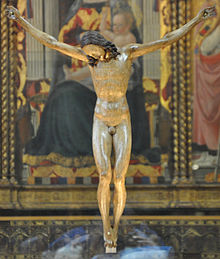
Michelangelo di Lodovico Buonarroti Simoni, known mononymously as Michelangelo, was an Italian sculptor, painter, architect, and poet of the High Renaissance. Born in the Republic of Florence, his work was inspired by models from classical antiquity and had a lasting influence on Western art. Michelangelo's creative abilities and mastery in a range of artistic arenas define him as an archetypal Renaissance man, along with his rival and elder contemporary, Leonardo da Vinci. Given the sheer volume of surviving correspondence, sketches, and reminiscences, Michelangelo is one of the best-documented artists of the 16th century. He was lauded by contemporary biographers as the most accomplished artist of his era.

The Madonna della Pietà, informally known as La Pietà, is a marble sculpture of Jesus and Mary at Mount Golgotha representing the "Sixth Sorrow" of the Blessed Virgin Mary by Michelangelo Buonarroti, now in Saint Peter's Basilica, Vatican City. It is a key work of Italian Renaissance sculpture and often taken as the start of the High Renaissance.

The Pietà is a subject in Christian art depicting the Blessed Virgin Mary cradling the mortal body of Jesus Christ after his Descent from the Cross. It is most often found in sculpture. The Pietà is a specific form of the Lamentation of Christ in which Jesus is mourned by sole privilege of the Virgin Mary alone, while representing her "sixth sorrow" and sometimes accompanied by a specific Marian title.

The Sistine Chapel ceiling, painted in fresco by Michelangelo between 1508 and 1512, is a cornerstone work of High Renaissance art.
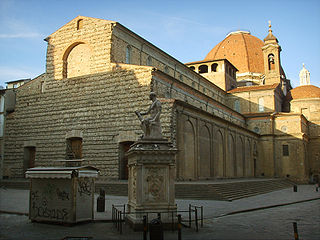
The Basilica di San Lorenzo is one of the largest churches of Florence, Italy, situated at the centre of the main market district of the city, and it is the burial place of all the principal members of the Medici family from Cosimo il Vecchio to Cosimo III. It is one of several churches that claim to be the oldest in Florence, having been consecrated in 393 AD, at which time it stood outside the city walls. For three hundred years it was the city's cathedral, before the official seat of the bishop was transferred to Santa Reparata.

The Bargello, also known as the Palazzo del Bargello or Palazzo del Popolo, is a former barracks and prison in Florence, Italy. Since 1865, it has housed the Museo Nazionale del Bargello, a national art museum.

The Agony and the Ecstasy (1961) is a biographical novel of Michelangelo Buonarroti written by American author Irving Stone. Stone lived in Italy for years visiting many of the locations in Rome and Florence, worked in marble quarries, and apprenticed himself to a marble sculptor. A primary source for the novel is Michelangelo's correspondence, all 495 letters of which Stone had translated from Italian by Charles Speroni and published in 1962 as I, Michelangelo, Sculptor. Stone also collaborated with Canadian sculptor Stanley Lewis, who researched Michelangelo's carving technique and tools. The Italian government lauded Stone with several honorary awards for his cultural achievements highlighting Italian history.

Bacchus (1496–1497) is a marble sculpture by the Italian High Renaissance sculptor, painter, architect and poet Michelangelo. The statue is somewhat over life-size and represents Bacchus, the Roman god of wine, in a reeling pose suggestive of drunkenness. Commissioned by Raffaele Riario, a high-ranking Cardinal and collector of antique sculpture, it was rejected by him and was bought instead by Jacopo Galli, Riario's banker and a friend to Michelangelo. Together with the Pietà, the Bacchus is one of only two surviving sculptures from the artist's first period in Rome.
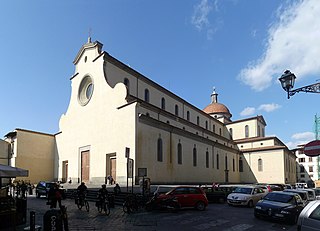
The Basilica di Santo Spirito is a church in Florence, Italy. Usually referred to simply as Santo Spirito, it is located in the Oltrarno quarter, facing the square with the same name. The interior of the building – internal length 97 m (318 ft) – is one of the preeminent examples of Renaissance architecture.

Palazzo Mozzi or Palazzo de' Mozzi is an early Renaissance palace, located at the end of the Piazza de' Mozzi that emerges from Ponte alle Grazie and leads straight to the palace where via San Niccolò becomes via de' Bardi in the Quartiere of Santo Spirito in the Oltrarno section of Florence, region of Tuscany, Italy. The 13th-century palace housed the gallery of the highly successful antiquarian Stefano Bardini, of which the remnants were left to the commune, where they assembled the Museo Bardini or Mozzi Bardini, displaying Florentine art and artifacts up to the early Renaissance. The gardens elaborated against the hillside behind the palace were added mainly by Bardini.

Benedetto Buglioni (1459/1460–1521) was an important Italian Renaissance sculptor specialised in glazed terracotta.
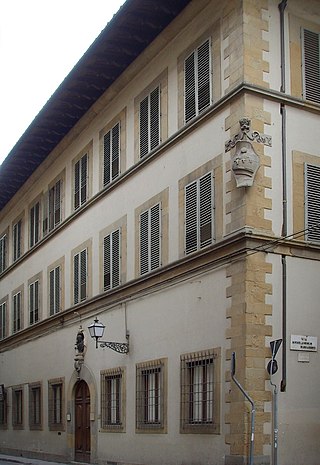
Casa Buonarroti is a museum in Florence, Italy that is situated on property owned by the sculptor Michelangelo that he left to his nephew, Leonardo Buonarroti. The complex of buildings was converted into a museum dedicated to the artist by his great nephew, Michelangelo Buonarroti the Younger. Its collections include two of Michelangelo's earliest marble sculptures, the Madonna of the Stairs and the Battle of the Centaurs. A ten-thousand book library includes the family archive and some of Michelangelo's letters and drawings. The Galleria is decorated with paintings commissioned by Buonarroti the Younger and was created by Artemisia Gentileschi and other early seventeenth-century Italian artists.
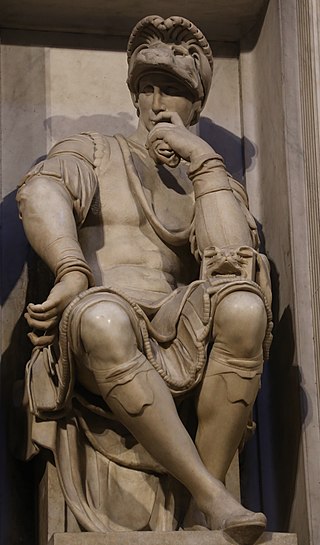
Michelangelo had a complicated relationship with the Medici family, who were for most of his lifetime the effective rulers of his home city of Florence. The Medici rose to prominence as Florence's preeminent bankers. They amassed a sizable fortune some of which was used for patronage of the arts. Michelangelo's first contact with the Medici family began early as a talented teenage apprentice of the Florentine painter Domenico Ghirlandaio. Following his initial work for Lorenzo de' Medici, Michelangelo's interactions with the family continued for decades including the Medici papacies of Pope Leo X and Pope Clement VII.
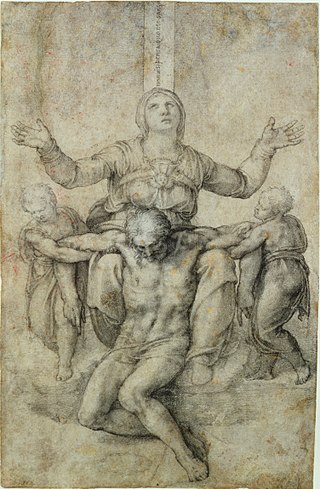
The Pietà for Vittoria Colonna is a black chalk drawing on cardboard (28.9×18.9 cm) attributed to Michelangelo Buonarroti, dated to about 1538–44 and kept at the Isabella Stewart Gardner Museum in Boston.
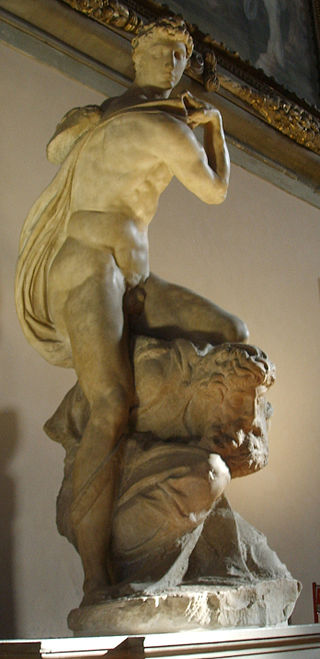
The Genius of Victory is a 1532–1534 marble sculpture by Michelangelo, produced as part of a design for the tomb of Pope Julius II. It is 2.61 m high and is now in the Salone dei Cinquecento of the Palazzo Vecchio in Florence.
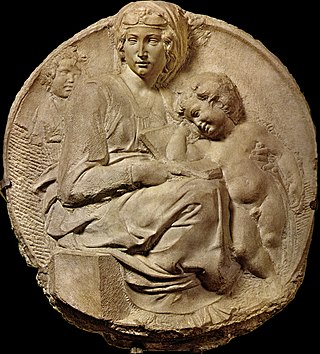
The Pitti Tondo is an unfinished marble relief of the Virgin and Child by Michelangelo in round or tondo form. It was executed between 1503 and 1504 while he was residing in Florence and is now in the Museo nazionale del Bargello in Florence.
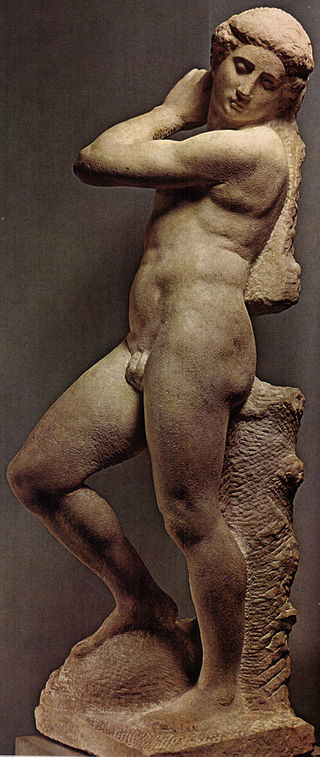
Apollo, also known as Apollo-David, David-Apollo, or Apollino, is a 1.46 m unfinished marble sculpture by Michelangelo that dates from approximately 1530. It now stands in the Bargello museum in Florence.

The Santa Croce Crucifix is a polychrome wood sculpture by Donatello, perhaps from c.1406-1408, or 1409–10. If the former is the correct dating, then Donatello was a young artist working in Lorenzo Ghiberti's workshop and beginning to get his own commissions. It is now in the Cappella Bardi di Vernio, just off the left transept of Santa Croce in Florence, Italy.

The Brunelleschi Crucifix is a polychrome painted wooden sculpture by the Italian artist Filippo Brunelleschi, made from pearwood around 1410-1415, and displayed since 1572 in the Gondi Chapel at the church of Santa Maria Novella in Florence. This idealised depiction of the crucifixion of Jesus measures around 170 cm × 170 cm. It is the only surviving wooden sculpture by Brunelleschi: the only other known example, a wooden sculpture of Mary Magdalene at the church of Santo Spirito, was destroyed in a fire in 1471. In his 2002 book, Masaccio e le origini del Rinascimento, the art historian Luciano Bellosi described Brunelleschi's crucifix as "probably the first Renaissance work in the history of art", representing a definitive turn away from the stylised postures of Gothic sculpture and a return to the naturalism of classical sculpture.

The Cappella di San Luca, also called dei Pittori is a chapel found in the cloisters of the convent of Santissima Annunziata in Florence, Italy. It was built to serve as the burial chapel for members of the Accademia del Disegno, and was donated by the Servites to the Academy in a document from 1565. It contains a collection of terracota statues from a number of prominent Florentine Mannerist sculptors.

